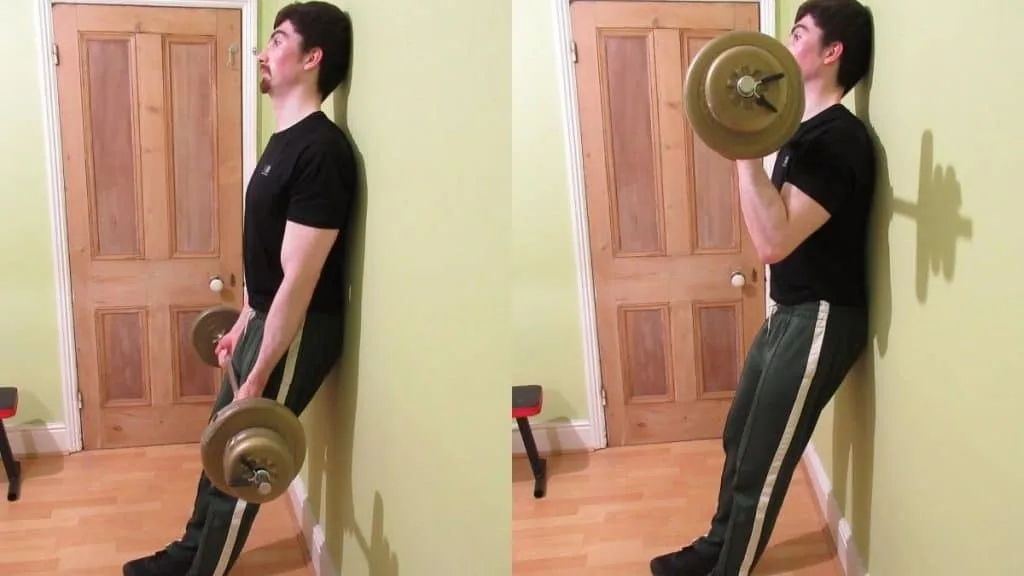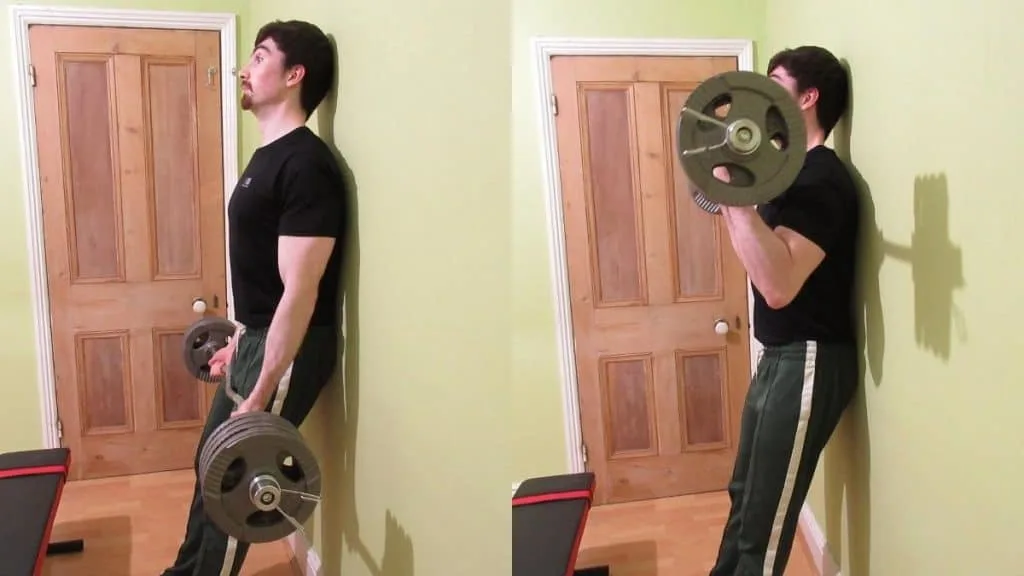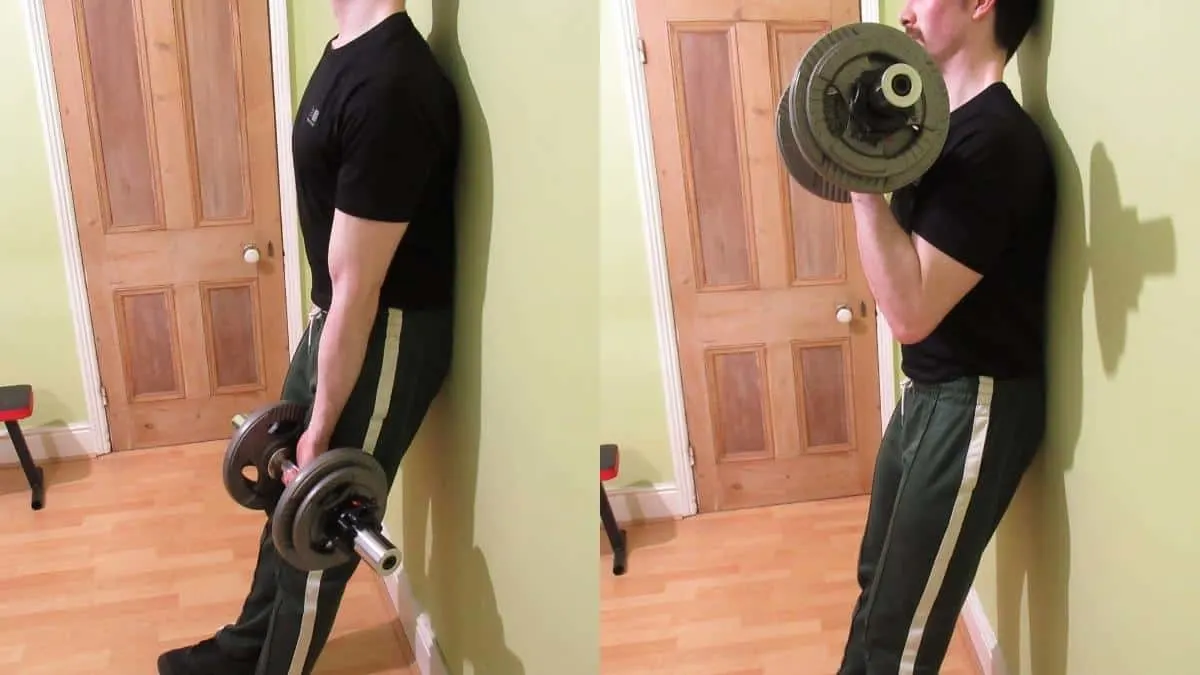The biceps brachii function to flex the elbows and supinate the forearms. Yet, so many lifters still use poor form during standing DB curls by swinging the weights up with their legs, hips, back, and shoulders (and sometimes all four body parts!).
Wall curls are like strict curls. They have you brace your glutes and upper back against the wall so that you can’t generate momentum to get the weights moving. So not only are wall curls an accurate way of testing your true bicep strength, they’re also an effective exercise for isolating the working muscle to make it grow bigger.
Related: Bicep and shoulder workout
Wall curl exercise details
- Main Muscles: Biceps brachii
- Secondary Muscles: Brachioradialis, brachialis, forearm flexors
- Exercise Type: Strength
- Exercise Mechanics: Isolation
- Difficulty Level: Beginner
- Equipment Needed: Dumbbells
How to perform wall curls
- Hold a pair of weights by your sides with an underhand grip.
- Stand up straight with your upper back and glutes pressed against the wall.
- Curl the dumbbells toward your shoulders while keeping your elbows still.
- Keep lifting until the undersides of your forearms make firm contact with your biceps.
- Squeeze your biceps forcefully at the top of the rep.
- Lower the weights under control until your elbows are fully locked out.
- Repeat for 3-5 sets of 6-15 reps.
Why do biceps curls against a wall?

While exercises like cheat curls can have their place if you use a controlled negative, wall curls completely remove the guesswork from figuring out how much stimulation your biceps are really getting.
For example, when you swing the weights up with momentum, it can be difficult to know if your biceps are actually getting stronger or whether you’re just using progressively worse forms of cheating.
With wall curls, on the other hand, you can be confident that your strength gains are legitimate because only your biceps are lifting the weights.
So if you struggle to use the correct technique during regular curls—or if you want to keep all of the tension on the working muscle for hypertrophy purposes—then it’s definitely worth performing the wall curl during your workout.
Wall curl variations
Doing the wall curl with dumbbells ensures that both of your biceps receive roughly equal stimulation. However, if you want to overload your muscles with the most weight possible, then you can do the barbell version instead.
Barbell wall curl

Performing bicep curls with a barbell is one of the most effective methods for adding mass to your upper arms. Unlike with dumbbells, you can load barbells in very precise increments so that you can gain strength faster, which in turn enables you to overload your biceps with more resistance.
The issue with barbels is that they encourage many lifters to swing the weight up with momentum because they’re so conducive to lifting heavy. So by doing barbell curls with your back against the wall, you can keep the usual cheating culprits—back, legs, hips, etc.—completely out of the movement.
To perform it, hold a barbell in front of your thighs with a shoulder-width supinated grip. Then, stand with your back and butt against the wall and curl the bar to your chest while keeping your shoulders stationary. Flex your biceps forcefully as your forearms press up against them, then lower the weight under control until you reach full elbow extension.
Perform 3-5 sets of 6-12 reps. You can also use higher repetitions if you’re doing the exercise later on in your workout to focus on the slow-twitch muscle fibers of the biceps.
EZ wall curl

If the straight bar puts too much pressure on your wrists and you don’t want to do a traditional standing or seated EZ bar curl, then you can do an EZ bar wall curl instead.
This kind of bar puts your hands in a semi-supinated (rather than fully-supinated) position. While this indeed takes a small amount of tension off the biceps, the difference in muscle stimulation is minimal. And besides, your brachioradialis and brachialis will get more work with the EZ version anyway.
The technique is the same as before. You grab the bar with a shoulder-width underhand grip and rest it against your thighs. Then you stand up straight with your glutes and shoulders blades braced against the wall.
From there, you simply curl the bar toward your chest while keeping your elbows still, squeeze your biceps, and then lower the weight under control until your arms are completely locked out. Again, you want to perform sets of 6-15 reps most of the time.
In conclusion
There’s no excuse to use suboptimal curling form now that you’re familiar with wall curls. You can use the movement as a primary exercise to build mass by isolating your biceps. Or, you can perform wall curls for a while and then switch back to regular curls (which you’ll be able to lift heavier on) once your form has improved.

